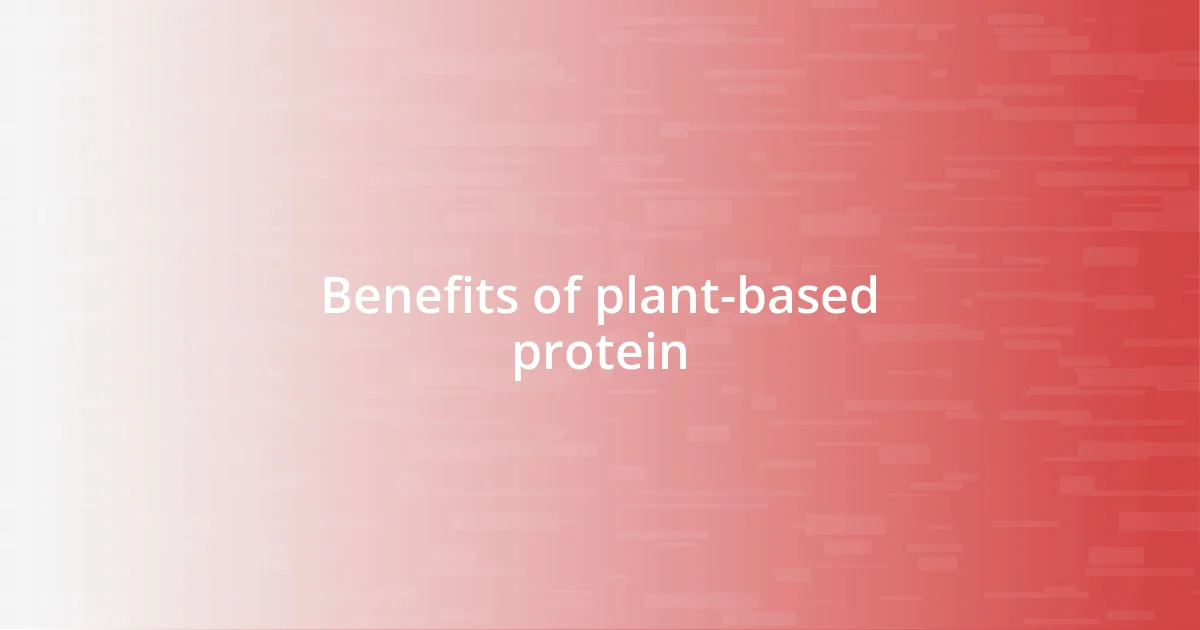Key takeaways:
- Plant-based proteins are versatile, can be combined for complete amino acid profiles, and provide rich nutrients beyond protein.
- Incorporating plant proteins supports improved digestion, lower environmental impact, and a range of health benefits including fiber and vitamins.
- Experimenting with various recipes and preparation methods enhances enjoyment and satisfaction while offering a delicious alternative to traditional protein sources.

Understanding plant-based protein
Plant-based proteins are derived from foods like legumes, nuts, seeds, and grains, and they play a crucial role in nutrition. I remember the first time I experimented with a chickpea salad; the texture and flavor surprised me—it was a complete meal that satisfied my cravings without the heaviness I sometimes felt with meat. Have you ever considered how versatile plant proteins can be in cooking?
One of the fascinating aspects of plant-based proteins is their rich diversity. While they often supplement our meals, I’ve found that they can stand alone as the star of the show. Picture a vibrant quinoa and black bean bowl topped with fresh avocado; I can almost taste it as I write! This blend not only packs protein but also provides essential nutrients, demonstrating how fun and delicious it is to explore beyond traditional proteins.
However, understanding plant-based proteins goes beyond just the ingredients. I’ve often encountered the myth that plant sources lack complete protein, which is simply not true. It’s a matter of combining different sources, like pairing rice and beans, that creates a full amino acid profile. Isn’t it empowering to know that with a bit of creativity, we can meet our protein needs naturally?

Benefits of plant-based protein
Plant-based protein sources come with a treasure trove of health benefits. I’ve often marveled at how incorporating these proteins has positively impacted my overall well-being. For instance, switching to plant-based options has improved my digestion, largely due to their high fiber content. Fiber is so crucial; it not only keeps things running smoothly but also helps me feel fuller longer—a definite win in my book!
One benefit I particularly appreciate is the lower environmental impact associated with plant-based proteins. I remember a conversation I had with a friend who was considering dietary changes for eco-friendly reasons. It struck me how much lighter a plant-based diet can be on our planet’s resources compared to traditional meat-heavy diets. Not only do I feel good about what I’m putting into my body, but I also take pride in making choices that benefit the Earth.
Moreover, plant-based proteins are often packed with a wealth of vitamins and minerals. When I whipped up a lentil stew last week, I was amazed by the colorful array of nutrients it brought to my plate. Each ingredient not only contributed to the protein content but also added its own unique set of health benefits. Who wouldn’t want a delicious way to nourish their body while enjoying flavors from nature’s pantry?
| Aspect | Plant-Based Protein |
|---|---|
| Health Impact | Improved digestion and nutrient absorption |
| Environmental Footprint | Lower than animal protein |
| Nutritional Benefits | Rich in vitamins, minerals, and fiber |

Popular plant-based protein sources
Plant-based protein sources truly offer a delightful variety that can jazz up any meal. I often find myself reaching for lentils when preparing a quick dinner. The other day, I made a fragrant lentil curry; the flavors combined with whole grains kept me satisfied and energized. It reminded me of how powerful these humble legumes can be—not just in nutrition, but also in bringing people together around a delicious meal.
Here are some popular plant-based protein sources to consider adding to your diet:
- Lentils: Packed with protein and fiber, they can be used in soups, stews, or salads.
- Chickpeas: Versatile and delicious, they’re great in salads, hummus, or roasted as a snack.
- Quinoa: A complete protein that cooks quickly and pairs well with many flavors.
- Tofu: A protein-packed favorite that absorbs any seasoning you throw at it.
- Nuts and Seeds: Almonds, chia seeds, and hemp seeds are easy additions to smoothies or oatmeal for extra protein.
- Edamame: Young soybeans that are tasty as a snack or tossed in salads for added texture.
I genuinely appreciate how these sources of protein have expanded my culinary experiments. Just last week, I made a delightful quinoa bowl topped with roasted chickpeas and a colorful array of veggies. The satisfying crunch of the chickpeas mixed with the fluffy quinoa was a simple yet fulfilling meal. These days, I enjoy exploring different combinations and flavors, and I can’t help but feel excited about the endless possibilities that come with incorporating plant-based proteins into my kitchen creations.

How to incorporate plant proteins
Incorporating plant proteins into your meals can be both fun and fulfilling. One of my favorite ways to do this is by blending them into smoothies. The other morning, I added a scoop of pea protein powder to my berry smoothie, and it gave it a fantastic creaminess and a protein boost. Have you ever tried tossing a handful of spinach or kale into your morning drink? It’s a game changer! Not only does it amp up the nutrition, but the flavors blend so well, you hardly notice the greens.
Another great tactic is meal prepping with plant proteins. I often prepare a big batch of chickpeas or lentils at the beginning of the week. These little powerhouses are so versatile! One time, I roasted chickpeas with spices for a crunchy snack, and the leftovers were a standout addition to my salads all week long. Isn’t it satisfying to know that a few simple ingredients can keep your meals interesting and packed with nutrition?
Don’t forget about experimentations—try new recipes that highlight different plant proteins. I recently discovered a black bean burger recipe that was simply incredible. The depth of flavor combined with the protein made it feel like comfort food, without the heaviness. Have you ever found a recipe that completely changed your perspective on a particular ingredient? I think that’s the beauty of cooking with plant proteins; there’s always a delicious surprise waiting to be unveiled!

Nutritional considerations for plant protein
When considering plant-based protein sources, it’s essential to look at their nutritional profiles. For instance, while legumes like lentils and chickpeas provide ample protein, they also pack a punch with fiber, which can aid digestion and keep you feeling full longer. I once noticed a significant difference in my energy levels after switching to a diet rich in these foods. Has it ever struck you how much lighter you feel when your meals are full of whole foods?
Another key point is that many plant proteins are not regarded as ‘complete proteins,’ which means they lack one or more of the essential amino acids our bodies need. For example, while quinoa does provide complete protein, many beans and nuts do not. I remember mixing black beans with rice in one of my meals and feeling that satisfaction when I realized I was getting a complete protein by combining those two. Have you ever tried pairing different sources to maximize your nutrition?
Lastly, while plant proteins offer numerous benefits, they can also pose certain challenges, especially for those transitioning from animal-based diets. Some people may need to experiment with texture and flavor profiles to find what they truly enjoy. Personally, I found that seasoning my tofu with various spices and marinades significantly enhanced my meals. Have you discovered a plant-based dish that completely surprised you with its flavor? The journey of exploring plant proteins often leads to delightful culinary discoveries!

Comparing plant and animal proteins
When I first switched to more plant-based sources, I found myself pondering the differences between plant and animal proteins. Animal proteins are typically complete, meaning they provide all the essential amino acids our bodies require in one package. I recall being surprised by how different my meals felt when I had to think about protein combinations to create something similar with plants. Did you know that by simply mixing legumes with grains, I could achieve a complete protein? It made me realize there’s a lot of creativity involved in plant-based meals!
The digestibility factor is another intriguing aspect. I noticed that while animal proteins can be easier to digest for some, my gut responded better to plant-based options. There’s something refreshing about knowing I’m fueling my body with whole, natural foods. Have you experienced a shift in your digestion after including more plants in your diet? It was a pleasant revelation for me, as I never expected to feel lighter and more energetic simply by switching up my protein sources.
While both protein types have their merits, I appreciate how plant proteins are often accompanied by additional nutrients, like vitamins and antioxidants, which are delightful bonuses. I started incorporating sources like hemp seeds and chia seeds into my breakfast, and I was amazed by the added benefits they brought. It felt nourishing—not just in terms of protein, but in providing my body what it truly craved. What about you—have you noticed how certain plant proteins can revitalize your meals in ways you never imagined? Exploring this realm rewards us with not just sustenance, but immense satisfaction!

Recipes featuring plant-based proteins
One of my go-to dishes featuring plant-based proteins is a hearty lentil stew. I love how the earthy flavors of lentils blend with spices like cumin and coriander, creating a comforting meal that warms the soul. It’s fascinating to see how a simple stew can become a nutrient powerhouse filled with protein and fiber. Have you ever experimented with spices in plant-based cooking? It can transform ordinary ingredients into something extraordinary.
Another favorite of mine is crafting a chickpea and spinach salad. The creamy texture of mashed chickpeas mixed with fresh greens and a zesty lemon dressing really brightens up the day. I often find myself reaching for this recipe when I need a quick, energizing lunch. It’s easy, satisfying, and bursts with flavor that keeps me coming back. Have you tried incorporating fresh herbs to elevate your salads? A sprinkle of cilantro can often be the game changer!
I also enjoy making a quinoa and black bean bowl topped with avocado and salsa. The combination is not just visually appealing; it offers a delightful burst of flavors that dance on the palate. I remember the first time I added avocado—its creaminess paired with the protein from quinoa and black beans made each bite feel indulgent yet wholesome. Have you ever felt a dish just click with your taste buds? This bowl has definitely captured my heart, and it’s perfect for meal prep too!












